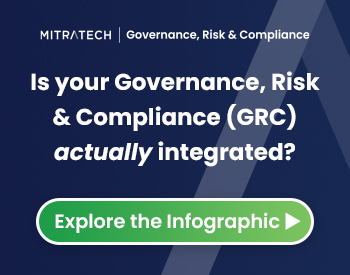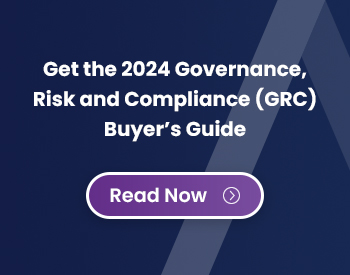5 Reasons to Invest in Enterprise Risk Management Software
From financial uncertainties to cybersecurity threats, regulatory changes, and everything in between, just how imperative is Enterprise Risk Management (ERM) technology in today’s business environment?
According to a report by SecureFrame, 41% of organizations have reported experiencing three or more critical risk events in the last 12 months. And while these threats have become more dynamic and frequent, new risk management dimensions across Third-Party Risk Management (TPRM), operational and cyber resilience, and more are emerging and expanding in importance.
To put it simply, risk managers are being called to meet higher standards, adhere to rising regulations, improve decision-making, demonstrate greater transparency in their risk management processes, and compress optimal reaction time (all while facing shrinking budgets and staffing challenges).
Enter Enterprise Risk Management (ERM) technology – the indispensable shield your business needs to thrive in an unpredictable world.
What is Enterprise Risk Management (ERM) Software?
Enterprise Risk Management (ERM) software is the technology that organizations employ to identify, assess, and prioritize potential risks that could impact their objectives. These risks can span a wide spectrum, from financial uncertainties to cybersecurity threats, regulatory changes, and everything in between. ERM provides a structured framework for proactively managing these risks, enabling businesses to make informed decisions, protect their assets, and enhance long-term sustainability.
Point vs. Platform: Why Invest in Agile ERM Technology Now?
In place of disparate, siloed solutions, teams now have the option of leveraging integrated ERM platforms. The comprehensive platform approach can help you understand and manage your risks in a holistic manner, considering both internal and external factors that could impact your objectives, operations, and strategic goals. There are 5 key reasons to consider investing in a modern, agile ERM platform for your organization.
 Proactive Risk Mitigation and Risk Assessment:
Proactive Risk Mitigation and Risk Assessment:
ERM technology allows businesses to move beyond a reactive stance and adopt a proactive approach to risk identification and risk management strategy. By leveraging advanced analytics and real-time monitoring, ERM empowers organizations to identify potential threats before they escalate, enabling timely and effective mitigation strategies. Not to mention, the best ERM platforms will come equipped with pre-built risk assessment templates, ensuring that you can start using the enterprise risk management solution immediately.
 Cost-Efficiency and Resource Optimization:
Cost-Efficiency and Resource Optimization:
Investing in ERM technology is a strategic move that pays dividends. Using automation, ERM software allows you to track what’s important and efficiently allocate resources based on identified risks to optimize costs, streamline operations, and ensure a robust financial position. The old adage, “prevention is better than cure,” holds true in the world of risk management.
In addition to monitoring program and policy improvements, ERM software also helps your team track remediation issues from audit findings, ensure your enterprise takes corrective action and makes necessary improvements, and then report on the status of tasks and corrective actions.
 Regulatory Compliance & Policy Management:
Regulatory Compliance & Policy Management:
In an era of ever-evolving regulations, non-compliance can be a costly affair. ERM technology equips businesses with the tools needed to stay abreast of regulatory changes, ensuring adherence and avoiding penalties. This not only safeguards the organization but also bolsters its reputation in the eyes of stakeholders.
Beyond assisting in audit management with workflows that enable you to easily schedule audits and notify departments, the right ERM platform can help you manage all of your policies, procedures, and enterprise documentation for your regulatory, legal, and compliance requirements. This includes managing expirations and updates, reporting that enables you to see calendar views and audit status at a glance, and more.
 Audit (and Reputation) Management:
Audit (and Reputation) Management:
Trust is a precious commodity, and a tarnished reputation can be challenging to recover. Not to mention, your board is poised to become more involved than ever in understanding and overseeing your IT risk technology — and they’re going to start asking more questions. ERM technology plays a pivotal role in safeguarding your brand by identifying and addressing risks that could potentially harm your organization’s image.
To that end, the best ERM technology will allow you to visualize and report on risk to management, the board, regulators, and auditors with a single click. Meanwhile, being able to monitor and report on things like Inherent Risk & Impact Assessments, Probability Assessments, Control Effectiveness Assessments, Inherent Probable Risks, Residual Risk. and more help your clients and stakeholders rest assured that your ERM program is cohesive and defensible.
 Future-Proofing Your Business:
Future-Proofing Your Business:
Whether you are just starting to implement GRC processes or looking to deploy next-generation GRC programs across your full enterprise, solutions that are scalable, flexible, and highly configurable by design are mission-critical.
A comprehensive solution can help you monitor and mitigate enterprise, cyber, and third-party risk with a holistic, 360-degree view of your operational risk management. And by providing decision-makers with a holistic view of potential risks, you’re empowering them to make well-informed and strategic decisions that consider both opportunities and threats down the line.
To that end, ERM technology equips organizations with the tools to navigate uncertainties in the short term, and adapt to changing environments for years to come, fostering resilience and agility in the face of unforeseen challenges.
How Do You Find the Right ERM Software for Your Organization?
Designing mitigation strategies is no longer enough. Business leaders need sophisticated analytics and expert insights to accurately navigate the diversity of risks their organizations now face. In other words, they need a holistic Enterprise Risk Management (ERM) solution capable of covering all bases, from risk identification to calculating value at risk.
To take your enterprise risk management from a conventional spreadsheet approach to one that identifies Value at Risk (including cyber and non-financial risks) and leverages highly integrated, AI-enabled tools to help you design more robust risk strategies, you’ll need to find the right solution.
Check out our ERM Buy In Guide for a closer look at how to evaluate your ERM technology based on the 6 pillars of end-to-end risk management:
- Defining context
- Identifying risks
- Qualifying risks
- Quantifying risks
- Managing risks
- Aggregating your portfolio
Elevate your GRC program today!
Reach out to our team with any questions, schedule a demo or learn more about Mitratech’s GRC solutions.





